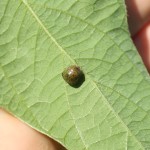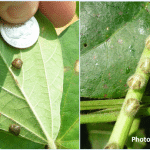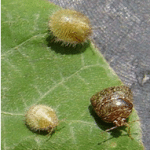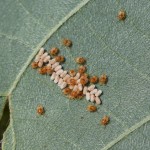This advice is primarily for those in east Tennessee and counties bordering the Mississippi and Alabama borders. The second generation flight of kudzu bugs has been active for the past couple of weeks. I’ve observed treatment level infestations in some fields in east Tennessee and in the Memphis area. It is likley that kudzu bugs have infested and are continuing to lay eggs in other soybean fields. Below are some tips for managing kudzu bugs.
- My first suggestion is to scout and don’t overreact to finding kudzu bugs in soybean. It requires a sustained and relatively high numbers of kudzu bugs to cause yield loss. They have sucking mouthparts and are typically found on stems feeding on plant sap. They do not feed on seed or chew holes in leaves.
- Learn to recognize the pest. I’ve included a few pictures below. The adults are pretty unique looking and can be easily identified with just a little experience. The immature stages are smaller, hairy nymphs that do not resemble the adults. There are a lot of other good pictures available on the internet (e.g., http://kudzubug.org/).
- Economic infestation are more likley in soybean fields in the vicinity of kudzu. Having a lot of kudzu close to your fields will increase your risk. However, kudzu bugs are strong fliers, so having kudzu immediately adjacent to a field is not necessary to have an economic damaging infestation.
- You don’t want to trigger insecticide application based only on the presence of adults. Allow infestations to establish themselves. The generally recommended threshold is to make an insecticide application when you average one nymph per sweep. If you spray on the front end of the migration, the adults often re-infest quickly and require a second treatment. One spray should be all it takes if you time things correctly.
- Use a recommended insecticide. For my money, it is hard to beat bifenthrin (e.g., Brigade) at 5-6 oz/acre. Acephate, Declare, Karate/Warrior, and Mustang Max are also labeled and effective. For whatever reason, Baythroid or Tombstone generally do not work well.





